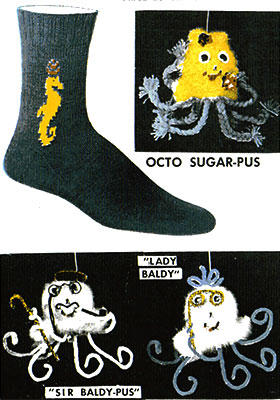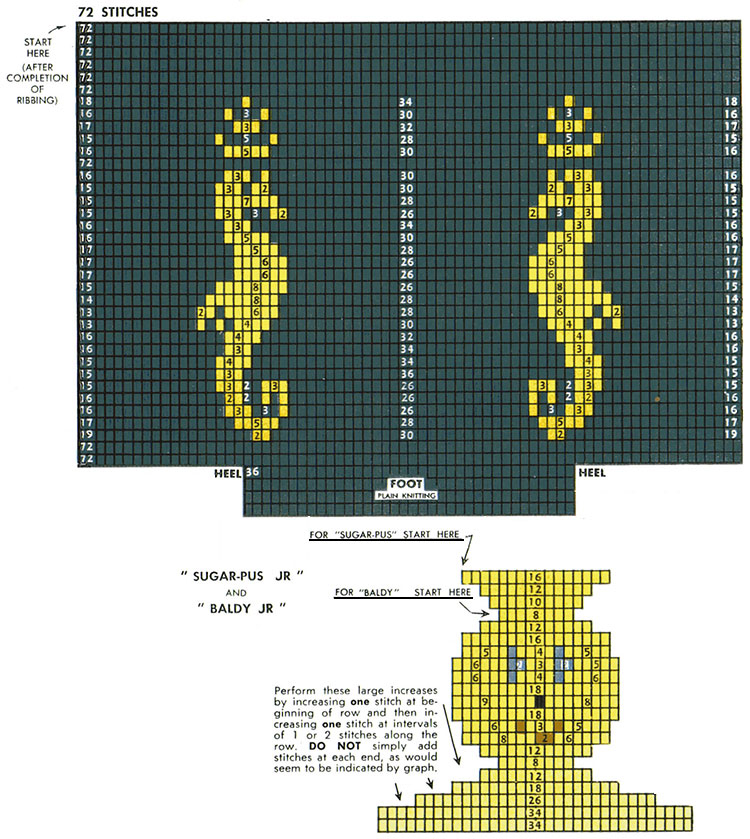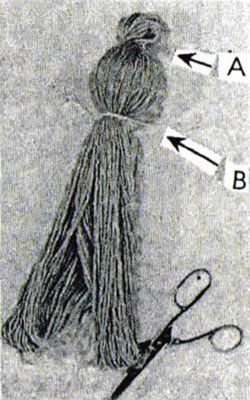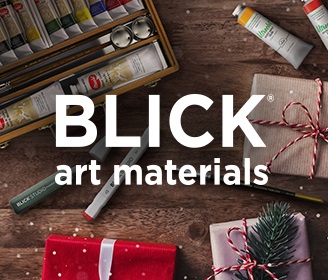Newly Added Knit Patterns
- Sugar 'N Cream Crochet Favorites | Book 62 | Lily Mills Company
- Knit Edging Pattern #8556
- Knit Edging Pattern #8549
- Knit Edging Pattern #8553
- Knit Edging Pattern #8541
- Knit Edging Pattern #8552
- Knit Edging Pattern #8555
- Knit Edging Pattern #8544
- Knit Edging Pattern #8547
- Knit Edging Pattern #8546
- Men's Sweaters | Book No. 99 | The Spool Cotton Company
- Hand Crochet | Book 4 | Royal Society
Sea Horse Clock Socks Pattern #72100

Simplified multi-color knitting with color charts. Stitch sequences numbered. Each row knitted across and purled back in the same colors.
IMPORTANT
Knit across and purl back each row before starting next row. Use size NUMBER ONE needles. Knitting tension should be tight enough to produce about 10 stitches per inch. If you do not obtain this gauge, then change to larger or smaller needles as your particular knitting tension requires. The size needle does not matter as long as the stitch gauge is correct. Note: 10 stitches per inch means 'as knit', without allowance for blocking. Socks then block to about 9 stitches per inch on usual size dryers, and will cling snugly to the average size leg when worn. For a very small size leg (such as 7 inches around above ankle) you may wish to knit to a tighter tension gauge than mentioned above, using the smallest possible needles. Use your own choice of yarn colors.
NOTE: (SOCK PATTERN)
IN CHOOSING YARN be sure colors selected are in good contrast to show the design in sharp detail. You may wish to knit the crown, as shown above sea horse's head, in a 3rd color. Suggested alternate colors: BLACK or NAVY BLUE sock with RED or WHITE sea horse and crown; BROWN with BEIGE or WHITE or YELLOW; CHARCOAL with CORAL; LT GREY with CORAL (BLACK crown); DARK GREEN with TURQUOISE and/or CORAL.
FOR SUGAR-PUS: Cast on 16 stitches and purl back to the beginning. Then to 2nd row, etc.
FOR BALDY (no top knot): Cast on 8 stitches and purl back to beginning. Then to next row, etc.
Perform increases or decreases at ends of each KNIT ROW, as called for by the graph. Be sure and purl EACH ROW back to beginning before going to next row.
Perform these large increases by increasing one stitch at beginning of row and then increasing one stitch at intervals of 1 or 2 stitches along row. DO NOT simply add stitches at each end, as would seem to be indicated by graph.
INSTRUCTIONS for knitting Angora face (head) of Octopus Charm. Knit the graph twice for each octopus. (Start on row #4 if you wish to omit top-knot). The 2 flat pieces then are sewed together to cover front and rear of octopus head, to form collar, top knot, etc. (Omit eyes, etc. when knitting rear piece).
IMPORTANT—Knit across and purl back EACH ROW before starting next row. (Each row shown thus represents 2 rows of usual knitting). Work must be correct size for snug fit around 2" diam. ball (Styrafoam or other type, light in weight) used to form core of head. Knit with #2 needles and with tension to produce approximately 7 stitches per inch. This will allow necessary stretch for smooth fit of Angora around head core. If you do not obtain this gauge, change to larger or smaller needles as your particular tension and yarn texture requires. The 100% French Angora is recommended for knitting this charm since it is the fuzziest. Approx. 15 yds. required.
CHOICE OF DECOR—Knit in the eyes, nose and mouth, if you wish, with alternate color yarn (plain yarn, not Angora); or these parts may be made of felt, beads, glass-jewels, rhinestones, or etc., which are simply sewed or glued on. (Use the new transparent plastic glue, for clean, positive results). Models shown have some of this alternate decor, including eyeballs that "move" in a transparent cover. (You'll love the changing expression on SUGAR-PUS with these eyes, as he sways around in your car—ask tor eyes at your dealer's).
DIRECTIONS
NOTE: Directions herein are complete, including recommended methods for heel and toe. Free detailed instructions for beginners on how to knit, purl, etc., should be obtainable where yarn is purchased.
MATERIALS—(Note: Different brands of yarn vary in yardage. The following yarn quantities for an average size pair of socks, are approximate only): 2½ oz. basic color (blue), ⅛ oz. yellow (gold) for sea horses, 3 yards for crowns if knit in a separate color.
Socks illustrated are 7 inches long above top of heel, including 2 inches of ribbing. If longer or shorter socks are desired, change length of ribbing or vary the number of plain rows above, or below, pattern design. Use size No. ONE sock needles, double pointed, and regular 3-ply sock yarn.
IMPORTANT (Handling Yarn)—Use needles and yarn in the above accurate sizes in order to have sock of proper size per this pattern. Knitting tension should produce 10 stitches per inch. Use BOBBINS to carry your yarn in small quantities of each color. These will dangle clear of your work, avoiding entanglement. For certain small areas of color involving only a few stitches, you may prefer to merely use SHORT STRANDS of yarn, 12 to 15 inches long, dangling free, instead of bothering to wind separate bobbins. RECOMMENDATION—Make free use of additional bobbins or short strands as new color groups are encountered. A given strand will often be used over again for stitches in the same color group in the following rows, so be sure it is started long enough for the color group it is to handle. CAUTION—It is not desirable to carry one color yarn across the wrong side of another color, to reach stitches of the same color farther along the row. This would save extra strands of yarn, but in so doing the tension variation is likely to cause distortion of the stitches and thus spoil the clarity of the design. In some cases this carry-over of yarn can be accomplished satisfactorily across only one or two stitches of another color, where design detail is not too critical. Some experienced knitters can carry yarn across even more than 2 stitches and avoid a loose loop on inside of sock by twisting the yarn carried with the yarn being worked, but the danger of design distortion must be considered. You will have a more beautiful finished article if separate strands are used freely. The only inconvenience is a few more yarn ends to take care of in finishing inside of sock.
RECOMMENDATION ON BOBBINS FOR THIS PATTERN—Use 3 bobbins of background color for the principal areas as separated by the sea horse designs. Use separate bobbins of color for each sea horse. Short strands will be satisfactory for the small areas of color in the crowns and for other small detached color groups. Total of 5 bobbins required (3 blue, 2 yellow) plus short strands.
LEG PATTERN—This part of sock is knitted in a flat piece, eventually to be folded and sewed together up the back. The successive rows on the pattern are knitted in order from left to right and each row is purled back. Each pattern row thus represents 2 rows of usual knitting. First cast on 72 stitches of basic color and knit 2, purl 2, for ribbing for 2 inches.
Knit the first 6 rows of pattern plain, always purling each row back to the beginning before starting next row. Knit the 7th row as shown on graph, that is: 18 blue, 1 yellow, 34 blue, 1 yellow, 18 blue. These numbers are indicated on graph to save counting squares. In changing colors always twist yarns around each other once to avoid leaving a hole. Now turn and purl back ON THIS SAME ROW using the same colors in the same spaces. Now knit row No. 8 in the indicated color sequences: 16 blue, 1 yellow, 3 blue … etc., and purl back as before. Continue knitting successive rows in this manner using the color sequences indicated on the graph. After row No. 36 the work separates to knit the heel. Divide the 72 stitches, taking 18 off each end and place on a separate needle for the heel. In so doing the leg of the sock is folded into position for sewing up the back later. Leave the 36 center stitches on one needle and discontinue work thereon while doing the heel.
HEEL—(Reinforced type) Using the 36 heel stitches, slip 1, knit 1 in sequence for the first row, then purl back. Continue thus in successive rows for 2 inches. On the last purl row, purl 20 stitches, then purl 2 together, purl 1 and turn work. Then:
Knit back 6, knit 2 together, knit 1, turn.
Purl back 7, purl 2 together, purl 1, turn.
Knit back 8, knit 2 together, knit 1, turn.
Purl back 9, … etc.
Knit back 10, … etc.
… Etc.
Continue in this manner, advancing the number of stitches worked at each end in this order, and thus making rounded bottom of heel, until all stitches are used, work then being all on one needle across bottom of heel. Now pick up stitches along the forward edges of the heel thus knitted, and add to the work in progress. About 21 or 22 stitches should be picked up on each side of the 2-inch long heel, and all of these heel stitches should be evenly divided on 2 needles.
INSTEP—At this point the entire sock is on three needles, consisting of the instep needle with the 36 center stitches (which must be kept separate), and the two underfoot needles on which the stitches along the edge of the finished heel are evenly divided. Now use a 4th working needle and knit the plain-color foot round and round as with plain socks, and at the same time form the triangular gusset which widens the ankle, by decreasing 1 stitch at the forward point of each underfoot needle ON EVERY OTHER KNIT ROW (single rows) until only 18 stitches remain on each underfoot needle. You will probably decrease 13 or 14 times depending on whether 21 or 22 stitches were picked up along the heel edge. Continue knitting the foot without further decreasing until 2½ inches from the desired length of the foot.
TOE—Now start decreasing to shape toe, as follows: Decrease 4 stitches on the next row, these being the end stitches on the instep needle, and the stitches next to these, one on each under-foot needle. Knit 4 rows plain then 1 row decreasing 4 stitches as before, 3 rows plain, 1 decreasing, 3 plain, 1 dec., 2 plain, 1 dec., 2 plain, 1 dec., 1 plain, 1 dec., then decrease every row until only 16 stitches remain (8 on instep needle and 4 on each underfoot needle). Weave toe as follows: Place yarn in a tapestry needle and, with yarn coming from back of knitting needle, put it in first stitch of front (instep) needle as if to knit and slip it off. Then put it in the next stitch of front needle as if to purl and leave it on. Go to back (underfoot) needle and insert as if to purl and take it off, then to next stitch of back needle as if to knit and leave it on. This designation may assist:
Front needle K—off P—on
Back needle P—off K—on
Repeat thus to the end of the 8 stitches on each needle.
FINISH—Sew sock up the back, using corresponding color of yarn and tapestry needle. Finish inside of sock by weaving any thread ends into nearby seams, trimming ends, etc. Block socks on dryers of proper size.
OCTOPUS CAR CHARM
MAKING OCTOPUS HEAD AND BRAIDED LEGS—Use regular sock yarn, approximately ¾ oz. required. Wind 120 loops on a piece of cardboard 16 inches long. Make a tight tie (with string) around entire mass of loops as near to end as possible (Point A in illustration). Insert a 2" ball (Styrafoam or other light weight ball) as foundation for head—as shown—and make a 2nd tie around entire mass of yarn, below the head thus formed (Point B). Cut yarn loops at extremities as indicated. Divide yarn strands into 24 groups or braids, each braid having 10 strands (approx.) Braid groups 3-together to form 8 legs. Tie yarn securely near extremity of each leg to insure braids staying in place. Cover tying strings with ribbons or any decorative material. A light wire may be worked through each leg if desired, to enable legs to be adjusted to various amusing positions. Braids can in fact be made independently on wires and fastened to bottom of head by merely inserting wire support into the styrafoam core.
KNITTING ANGORA FACES—See directions on face of pattern for knitting the Angora pieces which form covering for octopus head. Each row shown on graph is knitted across and purled back. In changing colors to form hair, eyes, nose, etc. always twist yarns around each other once to avoid leaving a hole. Stitch count of each color is shown by numbers—this saves counting squares.
When completed, block and press the knitted pieces flat first, then sew the 2 pieces together, stretching neatly around head foundation. Sew with matching color thread or yarn (not Angora) striving for a smooth, rounded appearance in the final article.
ALTERNATE DECORATION FOR CHARMS—Place finishing decor on your octopus in any way that strikes your fancy using material—sequins, beads, etc., that you may have on hand. Pipe cleaners alone, make amusing legs as seen on charms illustrated. "Lady Baldy's" lorgnette is made of a colored (gold metallic) pipe cleaner, as is also "Sir Baldy's" cane. The latter's beret is a cap from a small can, his glasses are made from a piece of fine black wire, and his pipe is fashioned from a piece of pencil with toothpick inserted for stem. Felt cutouts may be made for many items and your hobby shop or yarn supplier can likely supply such items as decorative artificial flowers, movable eyes, etc. Most of these are simply glued on. The new plastic glues are cleanest and best for this.
For "Sugar Pus" the Angora top-knot simply fits around the cut loop ends of yarn which protrude there as a tufted mass. If this yarn is left out (using pipe cleaner legs) the Angora top-knot is simply drawn together and sewed into an attractive "hair-do" effect.
GENERAL DIRECTIONS
Each square equals one stitch, knitted and/or purled. Sequences of stitches in particular colors to form a pattern are shown in color and by numbers on the specific pattern graphs. This saves counting squares. The number of row and number of stitches in each, depend on the symmetry of the pattern design, also on the approximate size of sock desired in order to fit the wearer's leg. Size and dimensions are indicated in each particular pattern.
Each row is normally knitted and purled back in the same colors. For certain patterns which are easily repeated, the knitter may, in purling back, go to the next row. In this case the indicated pattern will be reduced in size by one-half, and the entire pattern must then be repeated in order to achieve the length indicated.
Heel, bottom of foot, and toe are knitted in the manner of plain socks. In certain patterns where the instep is a plain color, and the same color as the foot, this part of the sock may be knitted round and round as in plain socks.


| Pattern Categories Browse the categories to help you find the patterns you're looking for. |
||
|
||










